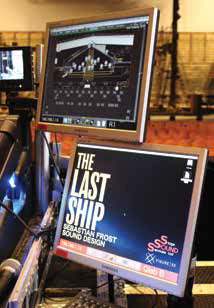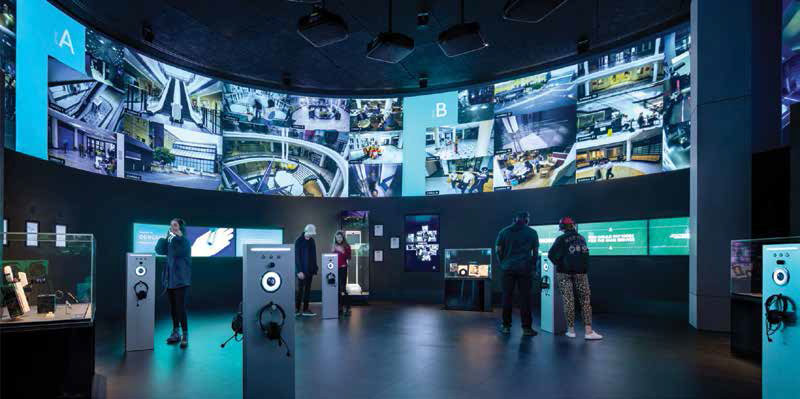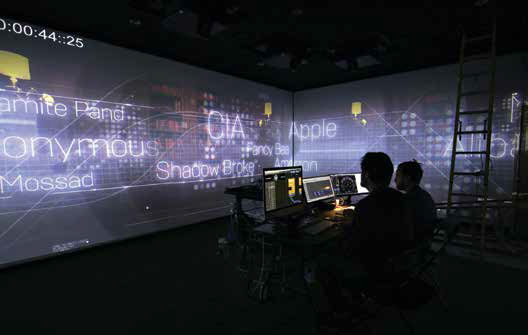The Latest in 3D Audio

Having celebrated its opening earlier this year, Spyscape in New York, NY is a new museum dedicated to the world of espionage. Over the course of a couple of hours, visitors are taken on a journey of the shadowy underworld of spooks both real and fictitious, and they’re even invited to test their skills. Think you’re a good liar? Do you vaunt your ability to keep a secret? Do you fancy yourself to be observant? At Spyscape, you’ll find out if you have what it takes to be the next James Bond or Lana Kane.

The Spyscape experience is an immersive one, complete with carefully crafted visuals and sound. At the heart of the museum’s audio system is L-ISA, L-Acoustics’ immersive audio system comprised of processing, mixing, and playback to deliver three-dimensional sound. Guillaume Le Nost, L-ISA research and development director at the loudspeaker manufacturer, headquartered in Marcoussis, France, explained that this is now possible thanks to a major shift in how audio is mixed. “One of the main technological developments [in immersive audio] is the move from channel-based mixing (mixing to a bus) to object-based mixing (mixing to a position),” he said. “[This] means that a mix can now be independent from a speaker reproduction layout.” He added that digital processing through FPGA (field-programmable gate array) or CPU (central processing unit) cores also contribute by allowing for “massive” multichannel sound processing in real time, and that audio-over-IP technologies facilitate the deployment of immersive speakers.

For performance venues, Le Nost pointed out that VR and AR are driving the demand for immersive audio. “Virtual reality and augmented reality use binaural technology to bring 3D sound to the experience, [and] live show expectations are fed by these other experiences,” he said. He also noted that 3D audio lets engineers “focus” sound, citing two main advantages this offers: “The first one is what L-ISA calls ‘hyperrealism’—the sensation of localizing the sound where the visual action takes place, to a point where one totally forgets the sound is reinforced,” he explained. “This is achieved by replacing the traditional L/R systems with a frontal array of at least five speaker points.” The second main advantage is what L-ISA refers to as “immersion”: it’s what gives audience members the feeling of being “in” the sound. “This can be achieved by extending the frontal array to surround or height speakers.”

In museums, this technology has the potential to contribute to the creation of what Le Nost dubbed “immersive realism” in interactive expositions, or for playback. “For playback, L-ISA is promoting a new reproduction format called Blu 23.1 that highlights all the benefits of 3D audio, and contains all other consumer formats,” he said. “This format is the result of years of research and is optimized to match human abilities to perceive sounds in space.” He added that he believes Blu 23.1 should garner interest among sound artists seeking a “no-compromise platform.”

Martin Audio, a loudspeaker manufacturer headquartered in High Wycombe, U.K., offers Sound Adventures, an object-based 3D immersive audio system that was created in partnership with Astro Spatial Audio, a sound technology developer based in Odiliapeel, the Netherlands. At the system’s core is the SARA II Premium Rendering Engine, and the technology has the capacity to move audio sources in real time, or via time-code, cue-based, or tracking systems. Again, the goal behind this is to enable audience members to hear the sound “objects,” rather than the loudspeakers themselves.
d&b Soundscape, developed by d&b audiotechnik, a loudspeaker manufacturer headquartered in Backnang, Germany, is an immersive audio system based on delay-based localization. The system combines three main components: d&b’s DS100 Signal Engine with Dante networking, the d&b En-Scene software module for sound object positioning, and the d&b En-Space, a software module that acts as a room emulator, enabling the addition or modification of a room’s reverberation signatures. Soundscape can be used in both fixed installations as well as on tour, and has been put to the test by a number of productions, including Sting’s Last Ship and Andrew Lloyd Webber’s updated Starlight Express.

“[Our point of view] is that with a channel-based system, it’s not possible to get a consistent sound image for the entire audience, [and that] everybody should hear the sound correctly—not just the people seated in the [center seating],” said Georg Stummer, product manager for Soundscape and the DS100 at d&b. “The second thing is, with an object-based system, the resolution of the many sound events that are taking place on stage is much higher than in a channel-based system.”
A daily selection of features, industry news, and analysis for tech managers. Sign up below.
For tech managers who find themselves delving into the world of immersive audio, Le Nost listed a number of questions to help guide the design process: Is the project about localization, immersion, or both? Is there a main “visual anchor,” such as a stage, involved? Will the sound be static, or will there be many trajectories? Will the experience involve interaction with the public? He also pointed out that 3D audio designs call for more speakers than traditional sound reinforcement designs, which heightens the level of required planning and coordination with those working in lighting, video, and rigging. To ensure as smooth a process as possible, he urges tech managers to plan ahead. “[My] main advice would be to think about sound as early as possible in a project,” he said.
Carolyn Heinze is a freelance writer/editor.
Info
ASTRO SPATIAL AUDIO
www.astroaudio.eu
D&B AUDIOTECHNIK GMBH
www.dbaudio.com
L-ACOUSTICS
www.l-acoustics.com
www.l-isa-immersive.com
SENNHEISER
www.sennheiser.com
Heady Stuff for Creatives
Sennheiser’s AMBEO Smart Headset for iOS is designed for content creators that want to capture 3D audio with their mobile devices. The headset, which creates binaural recordings, is equipped with two omni-directional mics in the earpieces, as well as an A/D converter, a mic preamp, and SoftLimit technology. The two microphones serve to capture the small differences in timbre, timing, and volume that surface as sound coming from difference directions arrives at each ear. Sennheiser says that when this captured audio is played back on stereo headphones, the sound is “lifelike.”
Carolyn Heinze has covered everything from AV/IT and business to cowboys and cowgirls ... and the horses they love. She was the Paris contributing editor for the pan-European site Running in Heels, providing news and views on fashion, culture, and the arts for her column, “France in Your Pants.” She has also contributed critiques of foreign cinema and French politics for the politico-literary site, The New Vulgate.
